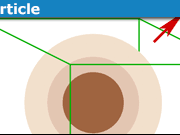Frequently Made Errors: Pseudo and Resultant Forces
Entire List for Frequently Made Errors Series
Table of Contents
1. Real versus Fictitious
Pseudo, or “fictitious“, forces can arise when a non-inertial frame of reference is used. Using a non-inertial frame makes the usual force/acceleration laws fail. Pseudo forces must be added to correct them.
2. Applied versus Resultant
The applied forces on an object are the specific forces exerted on it by other objects. A resultant force is a force that would be equivalent to some combination of applied forces.
Pseudo forces act as though they are applied forces.
3. Inertia
For an accelerating mass m in an inertial frame we have the standard equations ##\vec {F_{net}} = \Sigma \vec F = m\vec a##.
If instead we use a reference frame with acceleration ##\vec {a’}##, the apparent acceleration will be ##\vec a – \vec {a’}##. To make the force equation right we have to add in a force ##\vec F_{a’} = -m\vec{a’}## to obtain
##\vec {F_{net}’} = \vec {F_{net}}+\vec F_{a’} = m\vec a-m\vec {a’}= m(\vec a – \vec {a’})##.
In the special case of a frame based on the mass itself, ##\vec a = \vec{a’}##, giving ##\vec {F_{net}’} =0##.
4. Centrifugal and Centripetal Forces
These are two ways of describing the force on an object associated with its movement in an arc.
- Centripetal view
X “In an inertial frame, the centripetal force is the applied force that makes the object move in an arc.”
Centripetal force is a resultant force, not an applied force.✓ “In an inertial frame, real applied forces have a real resultant force producing all the acceleration. The component normal to the velocity is termed the centripetal force.”
Degenerate example: A satellite in a circular orbit experiences the applied force of gravitational attraction to its host. Since there are no other applied forces, this equals the resultant force. Since the orbit is circular, this force is always perpendicular to the velocity, so it constitutes the centripetal force.
[Arguably, it is better to avoid the term centripetal force altogether and only refer to centripetal acceleration.]
- Centrifugal view
In the reference frame of the circling object, there is no radial acceleration. To get the forces to balance, we need to invent an applied force equal and opposite to the inertial frame’s centripetal force. This is termed the centrifugal force.
Example: A motorcyclist on a “wall of death” experiences an increased reaction force from the saddle. This provides the centripetal force. To the motorcyclist, it feels like she is being pressed against the saddle by a centrifugal force.
5. Coriolis Force
Example: A skater spinning with arms outstretched draws his arms into his chest.
Viewed in an inertial frame, conservation of angular momentum about the skater’s axis increases his angular speed.
To the skater, a Coriolis force exerts a torque acting on his arms.
*Some prefer to avoid the terms ‘centrifugal force’ and ‘Coriolis force’, preferring instead to centrifugal and Coriolis accelerations. It’s a matter of taste. To an individual experiencing a rotation, it does feel like a force. Since it is not an actual applied force, it is called a fictitious force.
Masters in Mathematics. Interests: climate change & renewable energy; travel; cycling, bushwalking; mathematical puzzles and paradoxes, Azed crosswords, bridge








Здесь собрана увлекательная и полезная данные по разнообразным направлениям.
Гости могут обнаружить ответы на актуальные темы.
Статьи пополняются регулярно, чтобы вы могли изучать свежую информацию.
Удобная организация сайта помогает быстро найти нужные разделы.
порно
Разнообразие рубрикаторов делает ресурс универсальным для многих пользователей.
Каждый сможет найти материалы, которые нужны именно ей.
Существование практических советов делает сайт ещё более ценным.
Таким образом, данный сайт — это интересный помощник важной информации для широкого круга пользователей.
I agree with the suggestion that the term term centripetal force be banned. One must understand that he term “centripetal” refers to a situation rather than an interaction. It is like calling some force as forward if it increases the speed and backward if it reduces the speed. Let us consider a point particle. what are the possibilities:
A. it is at rest permanently so a = 0 and resultant applied force on it is zero.
B. momentarily at rest, the one needs to find the direction and magnitude of its acceleration, a. “ma” will then be the the resultant externally applied force on the particle.
C. Moving in a straight line, find the direction and magnitude of its acceleration, a. “ma” will then be the the resultant externally applied force on the particle.
D. If the particle is moving along a curve, then, the resultant force on it may have a tangential component and a normal component. Normal component can change only the direction and not the speed and thecomponent tangential can only change the speed and not direction. This normal component is what we call centripetal force.
Coming to the term fictitious to centrifugal force is also not proper as its effects are real in a non inertial frame. The term pseudo is more preferable. It is teh term added to make Newton’s laws applicable to non-inertial frames.
“1. Real versus Fictitious
Pseudo, or “fictitious“, forces can arise when a non-inertial frame of reference is used. Using a non-inertial frame makes the usual kinematic laws fail. Pseudo forces must be added in to correct them.
This statement is nonsense by definition of the term kinematics. Kinematics is, by definition, the description of motion without regard to forces. It uses whatever coordinate systems are convenient for the problem at hand, some likely to be inertial while other clearly are not, but all of that is irrelevant.”
Yes, kinematics was the wrong word. I’ll correct it.
“5. Coriolis Force
A Coriolis force arises from radial motion in a rotating reference frame.
This is muddy thinking. There is a Coriolis acceleration that arises at times, but there is no Coriolis force. When the Coriolis acceleration is multiplied by a mass factor, the result is an inertial reaction term, an M*A term, but it is not a force.
(And no, Newton’s Law does not say that any particular M*A term is a force. It says that the sum of all actual forces is equal to mass*acceleration of the cm for a particle (which is the particle location itself). Randomly chosen M*A terms are not forces, certainly not actual forces.)”
The same objection can be made to the term “centrifugal force”. Bear in mind that by definition a fictitious force is one that the observer invents to account for the experience, so it is reasonable to say that there is a Coriolis force. I’ll try to make this clearer.
“”Centrifugal view
In the reference frame of the circling object, there is no radial acceleration.”
Of course there is radial acceleration: v^2/r.”
In the reference frame of a given object, that object has no acceleration by definition.
“What if there is a tangential force as well as a radial force?”
I was careful (I think) to refer always to the radial component of the resultant.
“In the case of an orbitting planet, the gravitational force is the only force and it is an applied force which results in the centripetal force (consisting of only gravitation).”
Exactly.
“In general, systems don’t have a single unique resultant force.”
They don’t? Well, they could reduce to a single force plus a screw … but otherwise?
“avoid the term centripetal force altogether”
Interesting suggestion. I’ll add that advice.
Newton’s second law says
$$sum_{i=1}^n vec{F}_i = vec{F}_1+vec{F}_2+cdots+vec{F}_n = mvec{a}.$$ The ##vec{F}_i##’s are the forces acting on a body — that is, the applied forces. The centripetal force is not an applied force, so it doesn’t appear as part of the sum of the forces. Note that in an inertial frame, an applied force should have a reaction counterpart, e.g., the Earth exerts a gravitational force on the Moon, and the reaction force is the Moon exerting a force on the Earth. In general, there is no reaction counterpart to the centripetal force because it’s not an applied force.
I agree with the suggestion to avoid the term [i]centripetal force[/i] altogether precisely because it leads to the misconception raised here. An object on a curved path instead experiences a centripetal acceleration ##a_c = v^2/r##, where ##v## is the object’s speed and ##r## is the radius of curvature.
A little confused about the applied vs resultant bit too. Having a hard time seeing the gravitational force on an orbitting planet as resultant but not “applied”. Probably an issue with definitions I’m not getting.
Unless its saying that the centripetal is generally resultant. In the case of an orbitting planet, the gravitational force is the only force and it is an applied force which results in the centripetal force (consisting of only gravitation).
“The distinction between applied and resultant force may be confusing. And even misleading, when you say that the centripetal force cannot be “applied” but only resultant. What if there is only one force acting on the body in circular motion? What if there is a tangential force as well as a radial force? Will their resultant be the centripetal force?”
The key word in the definition given is that the centripetal force is a resultant force but not the resultant force. In general, systems don’t have a single unique resultant force.
5. Coriolis ForceA Coriolis force arises from radial motion in a rotating reference frame.This is muddy thinking. There is a Coriolis acceleration that arises at times, but there is no Coriolis force. When the Coriolis acceleration is multiplied by a mass factor, the result is an inertial reaction term, an M*A term, but it is not a force.(And no, Newton's Law does not say that any particular M*A term is a force. It says that the sum of all actual forces is equal to mass*acceleration of the cm for a particle (which is the particle location itself). Randomly chosen M*A terms are not forces, certainly not actual forces.)
1. Real versus FictitiousPseudo, or “fictitious“, forces can arise when a non-inertial frame of reference is used. Using a non-inertial frame makes the usual kinematic laws fail. Pseudo forces must be added in to correct them.This statement is nonsense by definition of the term kinematics. Kinematics is, by definition, the description of motion without regard to forces. It uses whatever coordinate systems are convenient for the problem at hand, some likely to be inertial while other clearly are not, but all of that is irrelevant.
"Centrifugal viewIn the reference frame of the circling object, there is no radial acceleration."Of course there is radial acceleration: v^2/r.
I never understood all this buzz about "fictitious forces", or a statement like " Using a non-inertial frame makes the usual kinematic laws fail". No, it does not. The equation of motion just doesn't transform covariantly under (linear or rotational) accelerations, as it does under Galilei transformations. That's the whole deal. And because one can state Newton's laws, just as special or General relativity, in a coordinate-free way using differential geometry, there is no reason to single out inertial frames of reference. When there are no forces, a particle follows a geodesic in Newtonian spacetime. This is a straight line, because space is flat. One can assign coordinate values to this line, giving that the second time derivative of x vanishes. If you then apply e.g. a time-dependent rotation R(t), such that x'=Rx, then automatically you get the centrifugal and Coriolis force. No talk about 'fictitious'.
The distinction between applied and resultant force may be confusing. And even misleading, when you say that the centripetal force cannot be “applied” but only resultant. What if there is only one force acting on the body in circular motion? What if there is a tangential force as well as a radial force? Will their resultant be the centripetal force?